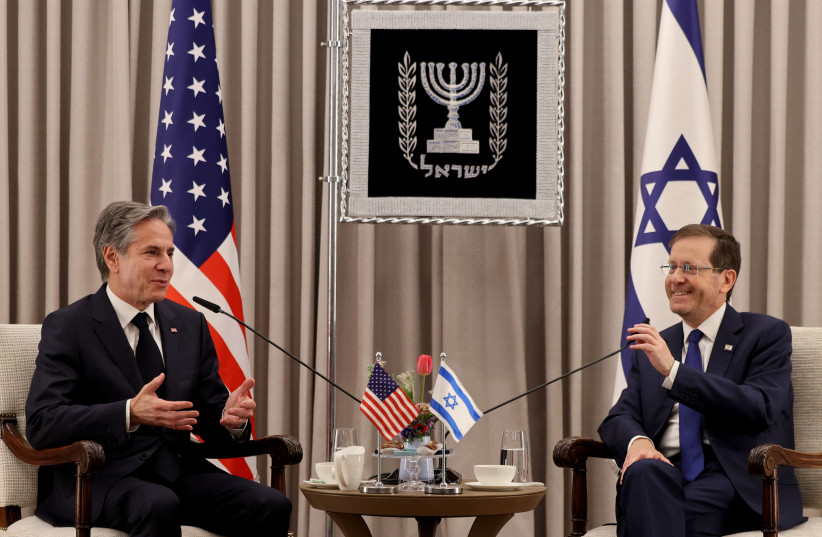US Secretary of State Antony Blinken meets with Israeli President Isaac Herzog, on January 30, 2023 in Jerusalem (credit: MENAHEM KAHANA/POOL VIA REUTERS)
Poor strategic choice by the US administration
Now on seven fronts, and after the two most significant ballistic missile attacks in modern history, the US administration’s demand for premature Israeli ceasefires with Iran, Hamas, and Hezbollah, all of whose radicalism and anti-Americanism are baked into their DNA, is a bad tactical as well as a poor strategic choice when the adversaries are on the defensive.
Longer-term foreign policy thinkers also misunderstand the region and do not work on Middle Eastern timelines. They are focused on the one-year war that began on October 7, which, in reality, is a distinct battle of much longer wars. If you see the multifront battles as isolated wars, not part of a longer and more complex Middle Eastern history, your recommendations will be lacking. Welcome to US foreign policy in the Levant for 76 years.
To develop a strategic plan for today’s Middle East, you need to consider all the wars, beginning in 1920, 1936, 1947-48, 1967, 1979, and 2000 – and that just touches the surface.
As Eli Lake discussed during a Bari Weiss Honesty podcast, radical Palestinian rhetoric and violence began in 1920 when the British created a new position, the chief mufti of Jerusalem, and placed at its helm Amin Haj Husseini, a rabid antisemite. Palestinian radicalism, and denial of a Jewish presence in Jerusalem, didn’t begin with Hamas and Palestinian Authority presidents Yasser Arafat and Mahmoud Abbas but had their roots over a century ago. Husseini worked with the Nazis, and those ideas became incorporated into the Hamas Charter.
In 1967, when Israel, in a defensive battle, conquered the West Bank, Sinai, and Gaza, the default answer was two states for two peoples. However, for the Palestinians and today’s college protesters, the war began in 1947-48 with the creation of a modern-day Jewish state, which they want to wipe off the map from the “River to the Sea.”
The Second Intifada, beginning in 2000, again proved that today’s wars are not territorial but existential. President Bill Clinton and the Israeli prime minister offered Arafat, the father of Palestinian nationalism as well as modern-day terrorism, a Palestinian state on 96% of the West Bank, with east Jerusalem as its capital.
The answer was six years of homicide bombings of Israeli civilians in buses, pizza parlors, and cafes. Abbas turned down 100% of the West Bank with land swaps in 2007. To understand Israeli millennials is to know they turned to the Right because they lived through the horrors of the early 2000s as children and teenagers.
A realistic and effective strategy for the Israeli-Palestinian conflict requires viewing the region as a whole. It needs to take into account the menace of an unreformable Iran and a panoply of Sunni jihadists, who sometimes work together, as in the case of Sunni Arab Hamas and Shi’ite Persian Iran.
It would help if American strategists did not look myopically at the most recent war, which began on October 7, 2023, but at all the wars in totality from the early days of modern Zionism until today. Then, you can understand which pieces of the contemporary Middle East must be transformed for real change.
October 7 began in many ways in 1979, the year of the Iranian Revolution. Without that revolution, Hamas, Hezbollah, and the Houthis would not be what they are today. If that revolution hadn’t happened, an Iranian nuclear program wouldn’t now be threatening Israel. Nor would billions have been transferred to Iran’s proxies who are terrorizing the region, and US soldiers would not have been killed by Iranian improvised devices in Iraq.
Each war should be understood as a building block and not in isolation. It should be acknowledged that without the demise of the current brutal Iranian regime, not much will improve. If American strategy is based on treating adversaries who support and finance terror as friends, as in the case of Qatar and Turkey, then its foreign policy strategy will do more harm than good.
To effect change in the Middle East, you need victories, not stalemates and premature ceasefires. Stopping Israel from inflicting decisive victories that will degrade the tentacles of the Iranian proxies is counterproductive to US interests and invites the next round of violence sooner rather than later.
As Iran continues to lose the potency of the proxies it relied on as a deterrent, it will accelerate its nuclear weaponization program. Do we have a strategy for that, or will we be dealing with the inevitable atomic arms race in the volatile Middle East?
Strategic patience along the Middle East’s timeline is the best way to achieve America’s goal of stability and prevent regional wars. Time will tell if the next administration will learn from our past mistakes or add to them.
The writer is the director of the Middle East Political Information Network and Mandel Strategies, and is the senior security editor for The Jerusalem Report. He regularly briefs members of the US Congress and their foreign policy aides on the Middle East.
